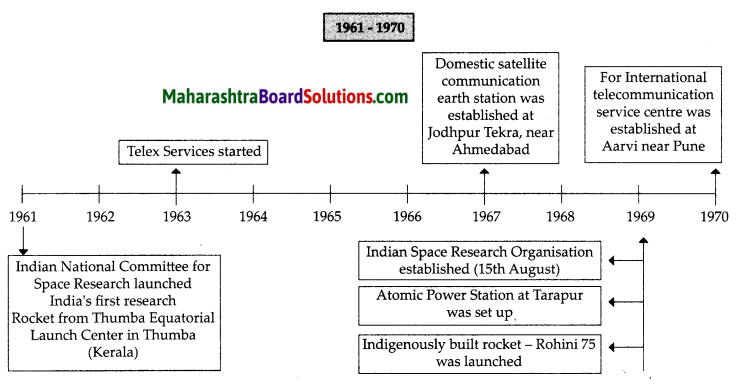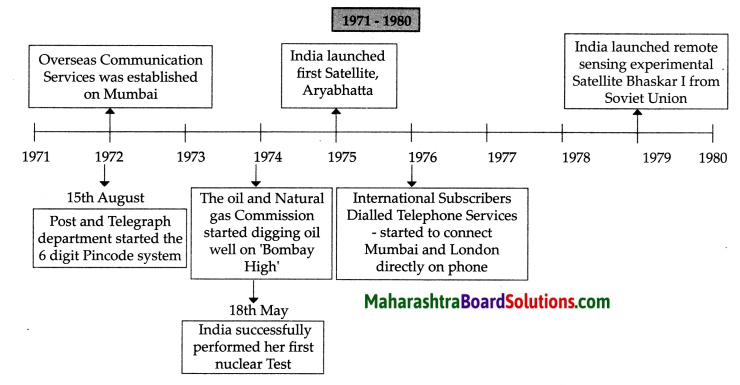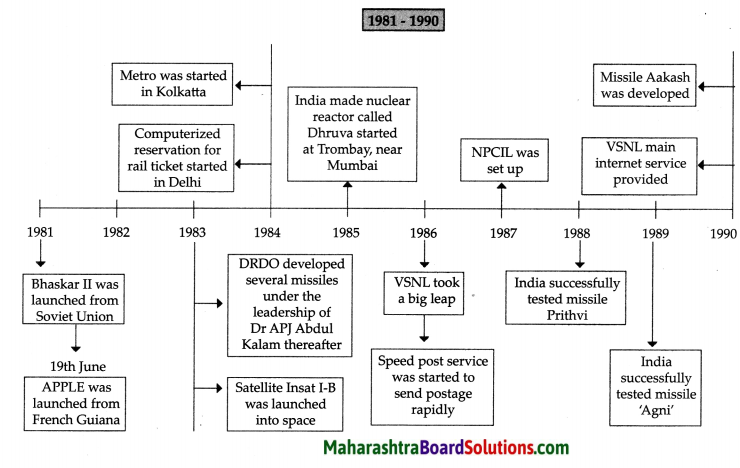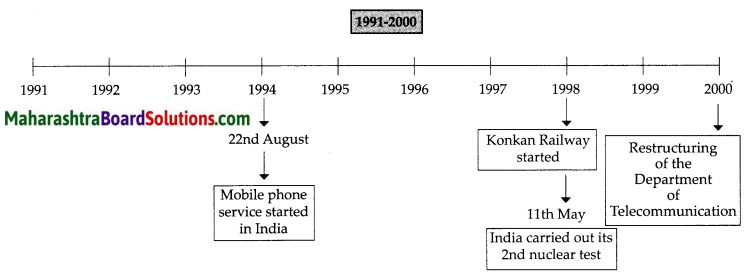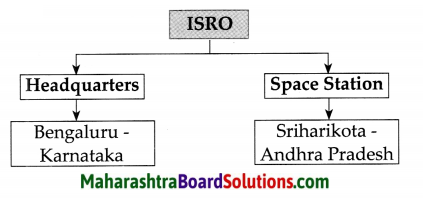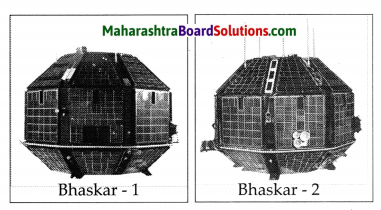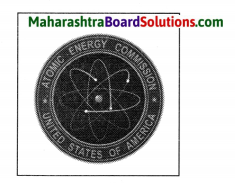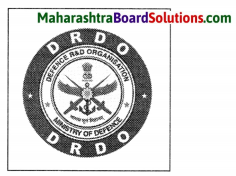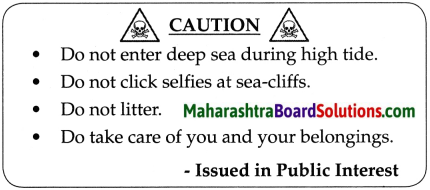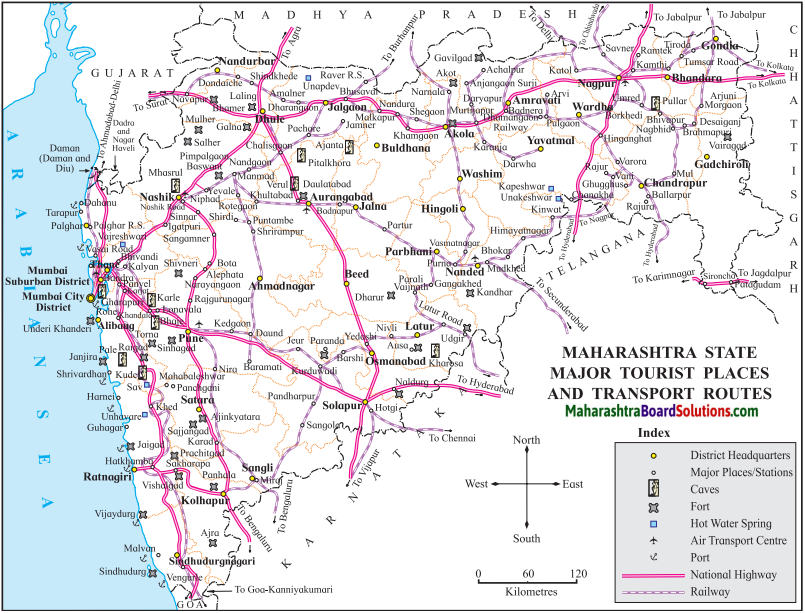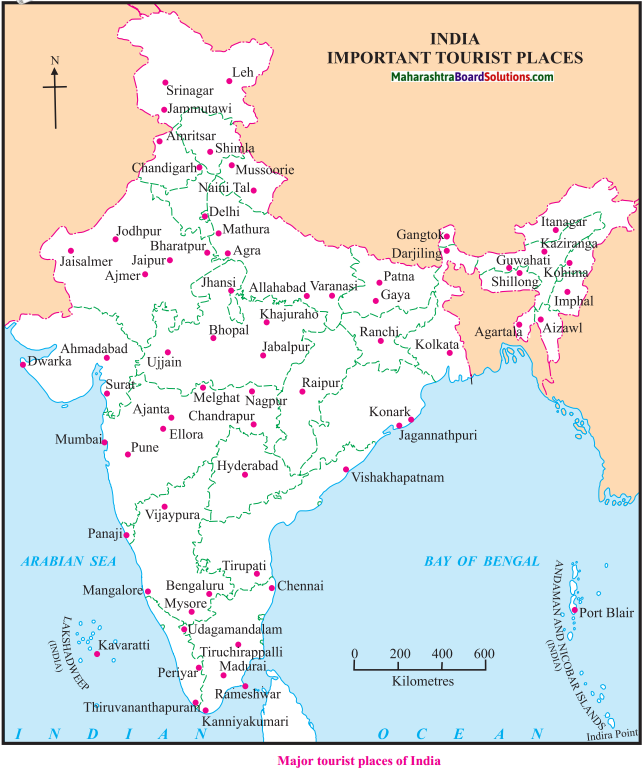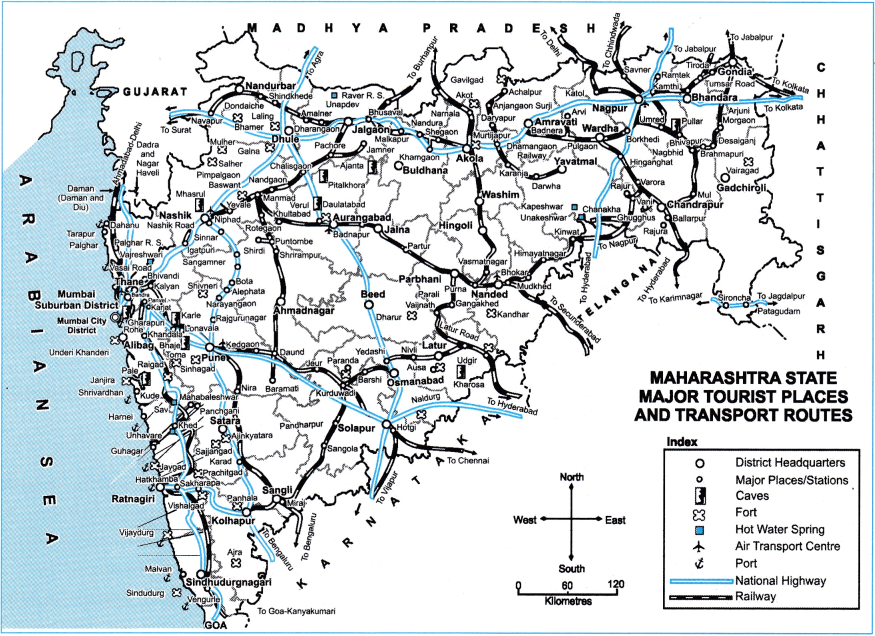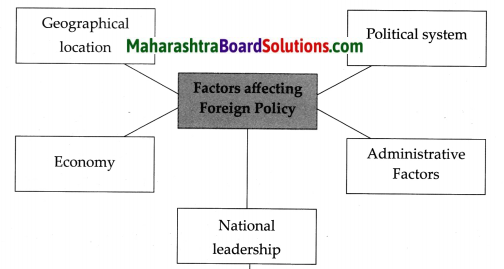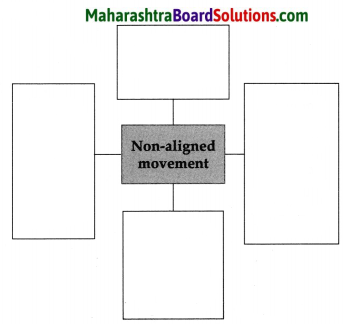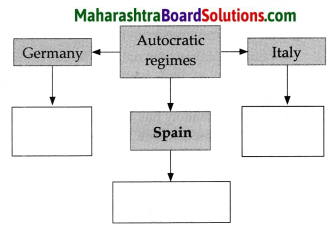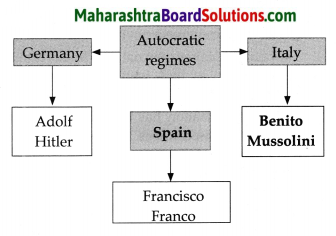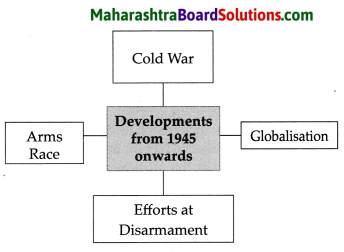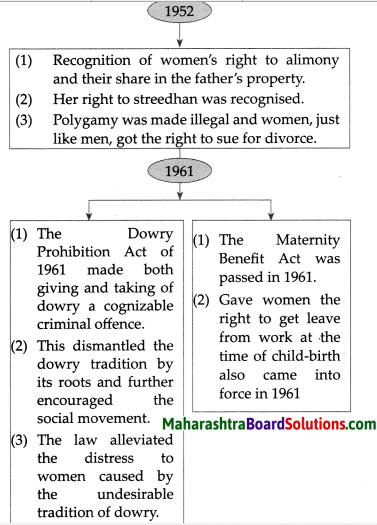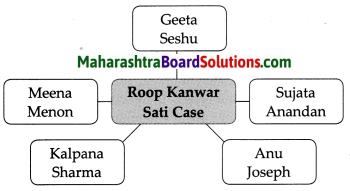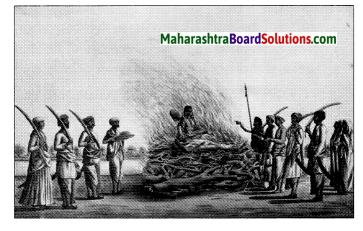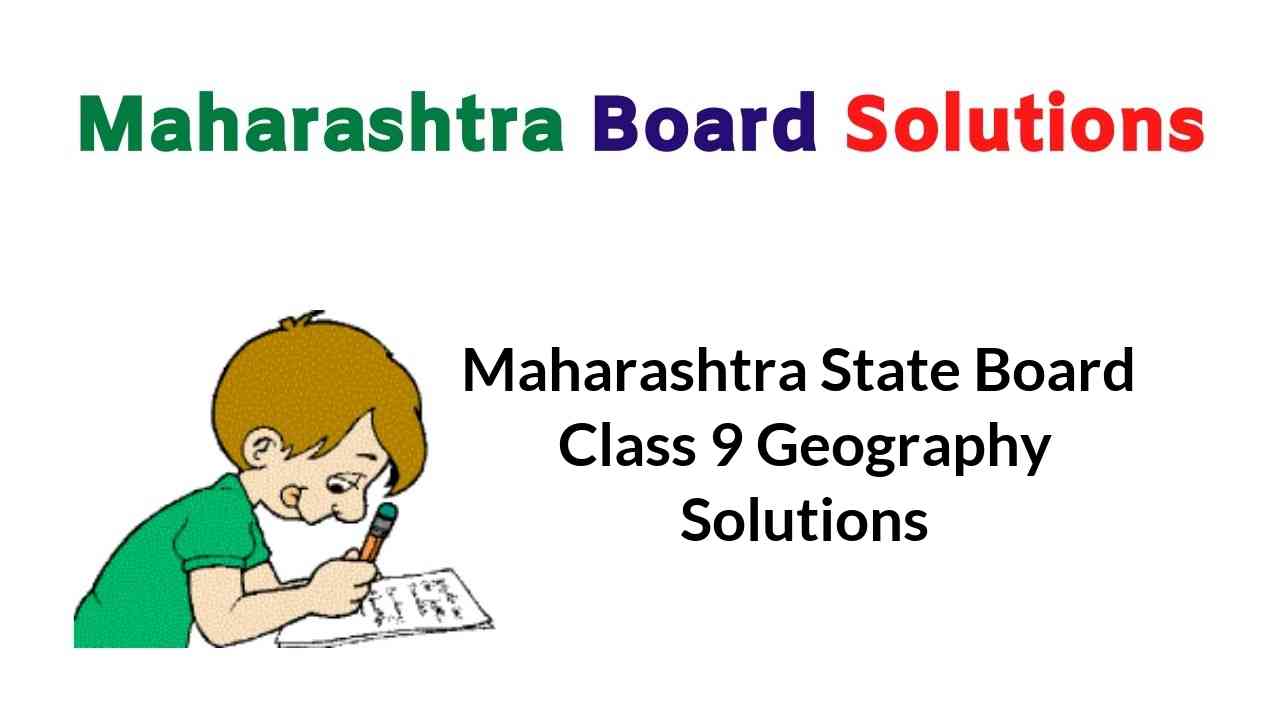Balbharti Maharashtra State Board Class 9 History Solutions Chapter 3 India’s Internal Challenges Notes, Textbook Exercise Important Questions and Answers.
Maharashtra State Board Class 9 History Solutions Chapter 3 India’s Internal Challenges
Class 9 History Chapter 3 India’s Internal Challenges Textbook Questions and Answers
1. Write briefly.
Question 1.
Which demands were put forward through the ‘Anandpur Sahib Resolution’ by the Akali Dal?
OR
Which demands were raised by the Akali Dal through the ‘Anandpur Sahib Resolution’?
Answer:
In 1973, the Akali Dal passed the ‘Aanandpur Sahib Resolution’. The following demands were made in this resolution:
(i) Chandigarh should be made part of Punjab.
(ii) The Punjabi speaking parts in other states should be included in the state of Punjab,
(iii) Recruitment of people from Punjab in the Indian army should be increased.
(iv) More autonomy should be given to the state of Punjab.
![]()
Question 2.
What can we do to end communalism?
Answer:
(i) It is necessary that we all counter communalism with all our strength. For this, we should mix with people of different religions. We should accept the good practices and ideas of each other.
(ii) We should be able to look at and understand our economic and social problems rationally. We should not mix these matters with religion.
(iii) We should look for the economic, political or historical reasons that are responsible for disrupting religious harmony. This is the only way to put an end to communalism and strengthen national unity.
Question 3.
How does regionalism gain strength/become strong?
Answer:
(i) Regionalism thrives on regional imbalance in development. In the post-independence period, some states achieved more progress, while some states remained backward.
(ii) As a result, the states that develop economically can also achieve progress in other areas like education, health and culture.
(iii) The states which have not developed in this manner remain backward in education and civic amenities. The opportunities of development available to people in developed states are not possible for people in backward states.
(iv) They are troubled by problems of education, backwardness, unemployment, poverty, etc. They begin to think that they are being cheated; they are being kept away from the benefits of development. Because of this, the understanding between states is broken.
(v) The people of developed states begin to believe that they are superior due to their superior history and culture and hence they have developed that much. Then they begin to look down upon the people of underdeveloped regions.
(vi) They are not willing to share the benefits of ‘ development with the backward states.
(vii) On the other hand, the people from backward areas need to arouse their regional identity to organise themselves. For this, they try to unnecessarily glorify local traditions.
2. Explain the following concepts in your own words:
Question 1.
Communalism
Answer:
(i) Communalism is a serious threat to the unity of our country. It emerges out of narrow religious pride.
(ii) Fanaticism is the base of communalism. It makes one oblivious to national interest. Fanaticism makes the perspective of looking at events and people prejudiced.
(iii) Some people begin to think of economic and social questions in the framework of their own religion. They hold the idea that government is partial towards their religion.
(iv) If anybody speaks about their religion or insults their religious symbols knowingly or unknowingly, riots break out because of this kind of thinking. Hundreds of innocent people are killed. Public peace is destroyed.
Question 2.
Regionalism
Answer:
(i) Regionalism refers an over-adherence to the language, culture, socio-political structures and economic growth of one’s own region or territory which leads to disregard for people of other regions.
(ii) It is grounded in the uneven industrial and infrastructural development of various regions of the same nation. For example, states like Maharashtra, Gujarat, Punjab and Tamil Nadu are well developed economically and industrially, whereas states like Odisha, Bihar, Assam, have remained undeveloped economically and industrially.
(iii) The disparity in availability of education, employment and other civic amenities between developed and backward regions of the country leads to regionalism.
(iv) The people of economically backward states often feel neglected and deprived, whereas the people of developed states might become narrow-minded and refuse to share the benefits of their development.
![]()
3. Give reasons:
Question 1.
It became necessary to carry out Operation Blue Star.
Answer:
(i) In 1980, the movement for ‘Independent Khalistan’ took root in Punjab.
(ii) During that period, the leader of the Akali Dal was Sant Harcharan Singh Longowal. He used to direct his activists from the Golden Temple to stage protests.
(iii) On the other side of the Golden Temple, armed followers started gathering around the staunch Khalistan supporter Sant Jamail Singh Bhindranwale. During that period, terrorist activities had begun.
(iv) Bhindranwale was arrested in 1981, accused of the murder of newspaper editor, Lala Jagatnarayan. After this incident, the situation worsened.
(v) Due to these developments, President’s rule was imposed in Punjab in 1983.
(vi) Bhindranwale went to stay at a religious place called Akal Takht.
(vii) Bhindranwale’s followers captured the Golden Temple and built a barricade of sand bags over there. The area looked like a fort.
(viii) This greatly disturbed peace in Punjab. It was a major challenge to Indian democracy.
Question 2.
We should fight communalism with all our strength.
Answer:
(i) It is necessary that we all counter religious communalism with all our strength.
(ii) For this to become a reality, we should mix with people of different religions. We should accept the good practices and ideas of each other.
(iii) We should be able to look at and understand our economic and social problems rationally. We should not mix these issues with religion.
(iv) We should look for the economic, political or historical reasons that are responsible for disrupting religious harmony.
(v) This is the only way to put an end to communalism and to strengthen national unity.
![]()
4. Write the full forms:
Question 1.
NEFA
Answer:
North East Frontier Agency
Question 2.
MNF
Answer:
Mizo National Front
Question 3.
NNC
Answer:
Naga National Council
Class 9 History Chapter 3 India’s Internal Challenges Additional Important Questions and Answers
Choose the correct option from the given options and rewrite the statements:
Question 1.
Akali Dal was the major political party of _______, which came to power in 1977.
(a) Haryana
(b) Punjab
(c) Rajasthan
(d) Gujarat
Answer:
Punjab
Question 2.
Akali Dal demanded ‘Holy City’ status for _______.
(a) Jalandhar
(b) Bhatinda
(c) Chandigarh
(d) Amritsar
Answer:
Amritsar
Question 3.
During the movement for ‘Independent Khalistan’ ______ was the leader of Akali Dal.
(a) Sant Jamail Singh Bhindranwale
(b) Sant Harcharan Singh
(c) Major General Shahbeg Singh
(d) Major General Kuldeep Singh Brar
Answer:
Sant Harcharan Singh
Question 4.
On the morning of 3rd June 1984, mission _____ started.
(a) Operation Blue Star
(b) Operation Black Thunder
(c) Operation Vijay
(d) Operation Smiling Buddha
Answer:
Operation Blue Star
Question 5.
The north-east consists of ____ states.
(a) 6
(b) 7
(c) 8
(d) 5
Answer:
8
Question 6.
In 1954, NEFA comprised of the territories on the ______ border and tribal areas towards the north of Assam.
(a) Indo-Pak
(b) Sino-Indian
(c) Indo-Nepalese
(d) Indo-Bhutanese
Answer:
Sino-Indian
![]()
Question 7.
In 1965, the responsibility of administering the north-east regions of India was given to _______.
(a) Defence Ministry
(b) Ministry of External Affairs
(c) President of India
(d) Pandit Jawaharlal Nehru
Answer:
Ministry of External Affairs
Question 8.
When India became independent, the government gave administrative autonomy to the districts of ______ majority areas of Lushai Hills.
(a) Naga
(b) Ahom
(c) Mizo
(d) Assamese
Answer:
Mizo
Question 9.
In 1961, Laldenga established the _______.
(a) All Assam Students Union
(b) Asom Gana Sangram Parishad
(c) Mizo National Front
(d) Naga National Council
Answer:
Mizo National Front
Question 10.
The Naga Tribe in north-east India was known to be a _____ tribe.
(a) nomadic
(b) pastoral
(c) martial
(d) ethnic
Answer:
martial
Question 11.
Naga National Council was led by ________.
(a) Prafullakumar Mohanto
(b) Laldenga
(c) Vizar Angami
(d) Angami Zapu Fizo
Answer:
Angami Zapu Fizo
Question 12.
The intense agitation of 1983 in Assam was staged over the question of _____.
(a) Exploitation by the landlords
(b) Bengali migrants from Bangladesh
(c) Autonomy in Assam
(d) Naxalites
Answer:
Bengali migrants from Bangladesh
Question 13.
On 20th February 1987, _______ got the status of a constituent state.
(a) Manipur
(b) Nagaland
(c) Assam
(d) Arunachal Pradesh
Answer:
Arunachal Pradesh
![]()
Question 14.
The Naxalite movement started at Naxalbari in ______ district.
(a) Darjeeling
(b) Hojai
(c) Bishnupur
(d)Tuensang
Answer:
Darjeeling
Question 15.
The Naxalites established an organisation called _____.
(a) North-east Frontier Agency
(b) People’s Liberation Guerilla Army
(c) Mizo National Front
(d) Naga National Council
Answer:
People’s Liberation Guerilla Army
Identify and write the wrong pair in the following sets:
Question 1.
(1) Greater Mizoram – Mizo National Front
(2) Aanandpur Sahib Resolution – Akali Dal
(3) Action Committees – Communalism
(4) Operation Blue Star – Kuldeep Singh Brar
Answer:
Wrong Pair: Action Committees – Communalism
Question 2.
(1) Laldenga – Chief Minister of Mizoram
(2) Lala Jagatnarayan – Naxalite
(3) Prafullakumar Mahanta-Assam Ganaparishad
(4) Jamail Singh Bhindranwale – Independent Khalistan
Answer:
Wrong Pair: Lala Jagatnarayan – Naxalite
Question 3.
(1) 1973 – Anandpur Sahib Resolution
(2) 1954 – NEFA became Arunachal Pradesh
(3) 1972 – Mizo areas got the status of Union Territory
(4) 1961 – Mizo National Front was established
Answer:
Wrong Pair: 1954 – NEFA became Arunachal Pradesh
![]()
Write the full form of the following acronyms:
Question 1.
PLGA
Answer:
People’s Liberation Guerilla Army
Do as directed
Question 1.
Complete the table using the information of Naxalite areas of activity provided in the chapter:
Answer:
| (1) | East Godavari | Andhra Pradesh |
| (2) | Adilabad, Bastar Rajnandangaon and Sukma | Chhattisgarh |
| (3) | Balaghat and Mandala | Madhya Pradesh |
| (4) | Gadchiroli, Bhandara, parts of Chandrapur | Maharashtra |
| (5) | Koraput | Odisha |
| (6) | Parts of Vishakhapatnam and Karimnagar | Telangana |
Write short notes on:
Question 1.
Military action was taken to suppress the skirmishes of Naga activists.
Answer:
(i) In 1946, some’ educated Naga youth established an organisation called Naga National Council (NNC).
(ii) Later they made a demand for an independent state of Nagaland. They were led by Angami Zapu Fizo.
(iii) In 1954, the Naga National Council announced the establishment of an independent federation of Nagaland.
(iv) In 1955, skirmishes took place between local Nagas and the soldiers of the Assam Rifles. Military action was therefore taken to suppress the skirmishes (clashes).
Question 2.
The Naxalites established an organisation called PLGA.
Answer:
(i) The Naxalite Movement originated from Darjeeling, West Bengal, to raise a voice against the exploitation of farmers by the landlords and to confiscate the lands of the landlords and distribute it amongst the tenants.
(ii) Later, the Naxalites took to terrorism and started a parallel system by rejecting democracy, thereby threatening the internal security of India.
(iii) The movement was mainly located in West Bengal.
(iv) Later, the movement spread to East Godavari in Andhra Pradesh and parts of Vishakhapattanam, Karimnagar in Telangana, Adilabad, Bastar, Rajnandangaon and Sukma in Chhattisgarh, Gadchiroli, Bhandara and parts of Chandrapur in Maharashtra, Balaghat and Mandala in Madhya Pradesh and Koraput in Odisha.
(v) In order to maintain their influence, the Naxalites established an organisation called People’s Liberation Guerilla Army (PLGA). This conflict is still going on.
![]()
Question 3.
Fanaticism is the base of communalism.
Answer:
(i) Communalism is a serious threat to the unity of our country. Communalism emerges out of narrow religious pride.
(ii) But when this pride becomes excessive, then it turns into bigotry.
(iii) Each one then begins to consider their religion superior and others’ inferior. This leads to religious fanaticism which is the base of communalism.
Question 4.
Regionalism thrives on regional imbalance in development.
Answer:
(i) In the post-independence period, some states achieved more progress, while some states remained backward.
(ii) States that develop economically can also achieve progress in other areas like education, health and culture.
(iii) The states which have not developed in this manner remain backward in education and civic amenities.
(iv) They are harassed by problems of education, backwardness, unemployment and poverty, etc.
(v) They begin to think that they are being cheated; they are being kept away from the benefits of development.
(vi) Because of this, the understanding between states is broken. This in turn, has a negative impact on national unity.
Question 5.
Skirmishes took place between local Nagas and the soldiers of Assam Rifles.
Answer:
(i) In 1946, some educated Naga youth established an organisation called Naga National Council (NNC).
(ii) Later, they made a demand for an independent State of Nagaland. They were led by Angami Zapu Fizo.
(iii) In 1954, the Naga National Council announced the establishment of an independent federation of Nagaland. In 1955, skirmishes happened between local Nagas and the soldiers of the Assam Rifles.
Question 6.
Naxalite movements are a threat to internal insecurity.
Answer:
(i) The movement had the objectives of establishing Action Committees to raise a voice against the exploitation of the farmers by the landlords and confiscate the land of the landlords and distribute it among the tenants.
(ii) Later, the movement strayed away from its objectives. It took recourse to terrorism to prevent any government schemes and welfare policies from reaching the common people.
(iii) The Naxalites started a parallel system by rejecting the democratic system. This made Naxalism a serious challenge to India’s internal security.
![]()
Answer the following:
Question 1.
Which event prompted the arrest of Jamailsingh Bhindranwale?
Answer:
Bhindranwale was arrested in 1981, accused of the murder of newspaper editor, Lala Jagatnarayan. After this incident, the situation in Punjab worsened.
Question 2.
Name the constituent states of the north-east of India.
Answer:
North-east India consists of the eight states of Assam, Arunachal Pradesh, Manipur, Meghalaya, Mizoram, Nagaland, Sikkim and Tripura.
Question 3.
What made the Mizo leaders demand autonomy for their province?
Answer:
(i) When India became independent, the government gave administrative autonomy to the districts of Mizo majority areas of the Lushai hills.
(ii) When the States Reorganisation Commission was appointed in 1954, the expectations of the people in this area grew. That is when the Mizo leaders started demanding an autonomous ‘Mizo’ province.
Question 4.
What do you mean by ‘Operation Black Thunder’?
Answer:
In 1986, an operation has to be conducted against terrorists in the Golden Temple. It was called ‘Operation Black Thunder’.
Question 5.
What was the objective of Naxalite Action Committees?
Answer:
The Naxalite movement had the objective of establishing Action Committees to raise a voice against the exploitation of the farmers by the landlords and to confiscate the lands of the landlords and distribute them among the tenants.
Read the following passages and answer the questions:
Passage: I
Mizoram : The tribes in north-east India have an ancient history. When India became independent, the government gave administrative autonomy to the districts of Mizo majority areas of the Lushai hills, When the States Reorganisation Commission was i ! appointed in 1954, the expectations of the people in this area grew.Mizo leaders started demanding an autonomous ‘Mizo’ province. In 1959 the territory of Mizoram experienced severe drought. During this famine, Mizo , leader Laldenga served the common people a lot. In 1961, Laldenga established an organisation called Mizo National Front (MNF). He asked for ‘Greater Mizoram’, an independent nation carved out of Tripura, Manipur and Mizo majority areas from the Lushai hills.
In March 1966, Mizo National Front announced the emergence of Independent Mizoram. Prime Minister , Indira Gandhi handled the situation firmly and suppressed the rebellion. When the situation calmed down in 1972, the Mizo majority area was given the status of a Union Territory. In 1985, Prime Minister , Rajiv Gandhi had an agreement with the Mizo National Front and Mizoram was given the status of a full-fledged State. Laldenga became the Chief Minister of the State.
![]()
Question 1.
Which areas in north-east eventually formed the state of Mizoram?
Answer:
Mizo majority areas of Lushai Hills formed the State of Mizoram.
Question 2.
Name the leading party of Mizoram.
Answer:
Mizo National Front.
Question 3.
Which operation was carried in 1986 against the terrorists in the Golden Temple?
Answer:
Operation ‘Black Thunder’
Passage: II
Nagaland: The Naga tribe in northeast India is known as a martial tribe. The Naga tribe had settled in Eastern Himalayas, the Naga hills, border areas of Assam and Myanmar. In 1946, some educated Naga youth established an organisation called Naga National Council (NNC). Later they made a demand for an independent State of Nagaland. They were led by Angami Zapu’Fizo. In 1954, the Naga National Council announced the establishment of an independent ,federation of Nagaland. In 1955, skirmishes happened between local Nagas and the soldiers of the Assam Rifles. Military action was taken to suppress the , skirmishes. Several rounds of discussions took place between the Central Government and the Naga National Council. Central Government decided , to give the Naga majority territory the status of a Union Territory. Nagaland was made a fullfledged State on 1st December 1963 by putting together the Naga majority territory and part of Tuensang.
Question 1.
Who was the leader of Naga National Council?
Answer:
Angami Zapu Fizo.
Question 2.
Which areas does Nagaland comprise of?
Answer:
Tribes residing in the eastern Himalayas, Naga Hills and on the border areas of Assam and Myanmar emerged as Nagaland. A part of Tuensang was also added to it later.
Question 3.
Which territory in the North-East eventually formed the state of Nagaland?
Answer:
Nagaland was made a fullfledged State on 1st December 1963 by putting together the Naga majority territory and part of Tuensang.
![]()
Answer the following questions in detail:
Question 1.
President’s rule was imposed in Punjab in 1983. Why?
Answer:
(i) In 1980, the movement for ‘Independent Khalistari took root in Punjab.
(ii) During that period, the leader of the Akali Dal was Sant Harcharan Singh Longowal. He used to direct his activists from the Golden Temple to stage protests.
(iii) On the other side of the Golden Temple, armed followers started gathering around the staunch Khalistan supporter Sant Jamail Singh Bhindranwale. During that period, terrorist activities had begun.
(iv) Bhindranwale was arrested in 1981, accused of the murder of newspaper editor, Lala Jagatnarayan.
(v) After this incident, the situation worsened. Due to these developments, President’s rule was imposed in Punjab in 1983.
Question 2.
Which states does north-east India comprise of and in what respects are they different from each other?
Answer:
(i) North-east India consists of the eight states of Assam, Arunachal Pradesh, Manipur, Meghalaya, Mizoram, Nagaland, Sikkim and Tripura.
(ii) International borders of India touch each of the states to varying extents.
(iii) These states are different with respect to ethnicity, language and cultural diversity.
Question 3.
State the role of Pandit Jawaharlal Nehru in the assimilation of the north-eastern states into the mainstream of the country.
Answer:
(i) The first Prime Minister of independent India took the lead in bringing the tribes living in these areas into the mainstream of the country.
(ii) In 1954, he formed the North-East Frontier Agency (NEFA) area, comprising of the territories on the Sino-Indian border and the tribal areas towards the north of Assam.
(iii) Nehru took the position of bringing about the development of hundreds of tribes in these parts while preserving their culture.
Question 4.
State the constitutional measures taken by the government to assimilate north-east India into the mainstream.
Answer:
(i) Special provisions have been made with respect to these areas in the VI Schedule of the Indian Constitution.
(ii) In 1965, the responsibility of administering this area was given to the Ministry of External Affairs.
(iii) The Northeastern Council Act of 1971 was supposed to advise the Central Government regarding aspects of common interest in economic and social spheres, inter-state transport, electricity, flood control, etc.
![]()
Question 5.
What is the role of Mizo leader, Laldenga in emergence of independent Mizoram?
Answer:
(i) In 1959 the territory of Mizoram experienced severe drought. During this famine, Mizo leader Laldenga served the common people a lot.
(ii) In 1961, Laldenga established an organisation called Mizo National Front (MNF).
(iii) He asked for’ Greater Mizoram’, an independent nation carved out of Tripura, Manipur and Mizo majority areas from the Lushai hills.
(iv) In March 1966, Mizo National Front announced the emergence of Independent Mizoram.
(v) In 1985, Prime Minister Rajiv Gandhi had an agreement with the Mizo National Front and Mizoram was given the status of a full-fledged state. Laldenga became the Chief Minister of the State.
Question 6.
Describe the establishment of democracy and peace in Assam.
Answer:
(i) In 1985, Prime Minister Rajiv Gandhi, Central Home Minister Shankarrao Chavan and Assamese leader Prafullakumar Mohanto signed an Accord.
(ii) It was dedded to that the Bangladeshi dtizens who had infiltrated in Assam would be sent back to their original places.
(iii) In 1986, elections were held for Assam Legislative Assembly and Prafullakumar Mohanto, of the Asom Ganaparishad became the new Chief Minister. Due to this democratic process, it became possible to establish peace in Assam.
Question 7.
What are the features of religious fanaticism?
Answer:
(i) People of different religions don’t trust each other. They become suspidous of each other.
(ii) Compatriots following different religions are looked at as enemies. Even commensality or coming together on festivals becomes rare.
(iii) The perspective of looking at events and people is prejudiced. Some people begin to think of economic and sodal questions from within the framework of their own religion.
(iv) Some people might think that since they belong to a particular religion, they have no influence in politics. They begin to believe that they are being treated unjustly. They hold the idea that the government is against their religion.
![]()
Question 8.
Regionalism can affect developed as well as undeveloped states. Justify the statement.
Answer:
(i) The people of developed states begin to believe that they are superior due to their superior history and culture.
(ii) They then begin to look down upon people of underdeveloped regions. They are not willing to share the benefits of development with backward states.
(iii) On the other hand, the people from backward areas arouse their regional identity to organise themselves. For this, they try to unnecessarily glorify local traditions and culture to prove their uniqueness.
Question 9.
What do you mean by ‘Operation Blue Star’?
Answer:
(i) Operation Blue Star was a military action of getting the terrorists out of the Golden temple. This operation was entrusted to Major General Kuldeep Singh Brar.
(ii) On the morning of 3rd June 1984, the mission ‘Operation Blue Star’ started. The Operation ended on 6th June.
Question 10.
Which events from the Golden Temple in 1980 disturbed the peace in Punjab?
Answer:
(i) In 1980, the movement for ‘Independent Khalistan’ took root in Punjab. During that period, the leader of the Akali Dal was Sant Harcharan Singh Longowal. He used to direct his activists from the Golden Temple to stage protests.
(ii) On the other side of the Golden Temple, armed followers started gathering around the staunch Khalistan supporter Sant Jarnail Singh Bhindranwale. During that period, terrorist activities had begun.

